Available historical records suggest that senkadagallapura (an early name for Kandy) was established by the King Wickramabahu during the period of his reign from, 1357-1374 AD. Some scholars contend that the original name of Kandy was Katubulu Nuwara located near present Watapuluwa. The more popular historical - Senkadagalapura - according to folklore, was originated from one of the several possible sources. These include naming after a Brahmin with the name Senkanda who lived in a cave nearby, a queen of a King Wickramabahu named Senkanda, and after a coloured stone named Senkadagala. The present name Kandy is only and anglicized version of Kanda Udarata (meaning the land of mountains) originated in the colonial - era.
After King Wickramabahu who funded the city, Senasammatha Wickramabahu ascended the throne in the 15th century (1473-1511) making it the new capital of the Kandian kingdom. He was followed by his son king Jayaweera Astan (1511-1551) later by Karalliyadde Bandara (1551-1581). His successor however, preferred to rule the hill country from Sithawaka on the western flanks of the hills. A period of turmoil for power ended with the ascent to the throne by Konappu Bandara who came to be known as Wimaladharmasuriya.
Wimaladharmasuriya having embraced buddhism consolidated his authority fur therby bringing the tooth relic of the Lord Buddha to Kandy from a place called Delgamuwa. He proceeded to the building temple for the sacred relic which subsequently developed in to the present Dalada Maligawa. In between the death of Wimaladharmasuriya in 1604 and the capture of the last King of Kandy by the British in 1815 seven successive Kings ruled the Kandian Kingdom from its base at Senkadagalapura or its suburbs such meda Maha Nuwara, Kundasale and Haguranketha. The beautiful octagon at the dalada Maligawa and the picturesque Kandy Lake were constructed during the time of the last King Sri Wickckrama Rajasinghe Who was exiled to south India by the British.
The history of Kandy it's townscape witness rapid and drastic change from the beginning of British rule particularly after the 1818 rebellion. As Sir Lowry in his Gazetteer recorded. "The story of English rule in the Kandyan country during the rebellion. of 1818 cannot be related without shame. Hardly a member of the leading families alive. Those whom the sword and the gun had spared, cholera and small pox and privations had slain by the hundreds. Others became ignorant and apthetic. Any subsequent development efforts of the government for many years were only attempts begun and abandoned".
However, Ananda Kumaraswami - the great savant of eastern culture writing in 1912 after nearly hundred years of British occupation had this to say. "Hardly mountaineers of the interior, preserved their independence enabling us to form an estimate of Sinhalese as a live and individual people, with a national character and a national art; an individuality and art which is more difficult and often impossible to trace in the low country districts long subjected to western influence ".
Since its founding in the 14th century, Kandy which remained the last stronghold if local kings had gone through many a vicissitude. Although Colombo represents the prime commercial and administrative center, Kandy continues to remain the cultural capital of Sri Lanka with a heritage of living monuments.
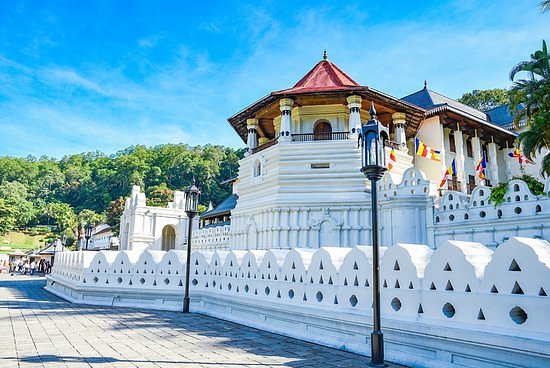
Undoubtedly the greatest attraction of the city is this building, the Temple of the Sacred Tooth Relic or the Dalada Maligawa. It is one of the most sacred places for the Buddhists all over the world. The temple is visited by thousands of devotees every day. Especially famous for its Sinhalese style architecture, the most dominant feature of the building is the Octagon (Pattirippuwa). This was the place from where the King addressed the public on important occasions.
On to the North- West of the palace, is the Maha Vishnu Dewale a shirne built in the 18th Century dedicated to God Vishnu of the Hindu Pantheon also worshiped by the Buddhists. On the upper terrace is the main linear building, a mug and stone structure on a podium, with an upper story at the Northern end above the sanctuary where the icon is placed. This building complex is entered through a two storyed Vahlkada (entrance doorway), to an open hall with timer columns in the middle terrace, a beautifully carved stone flight of steps and the grooming hall. On the upper terrace is another small shrine, the God Dedimunda's shrine and a large bo - tree.
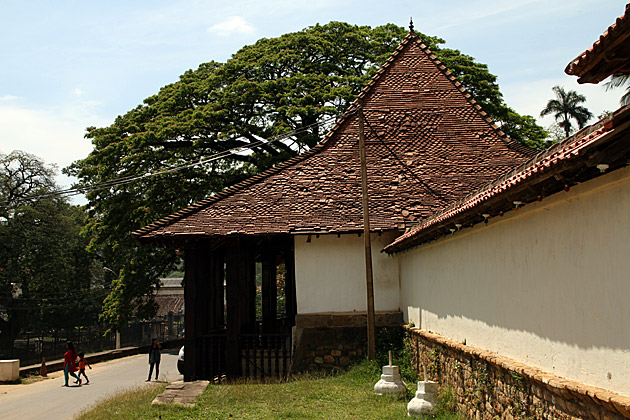
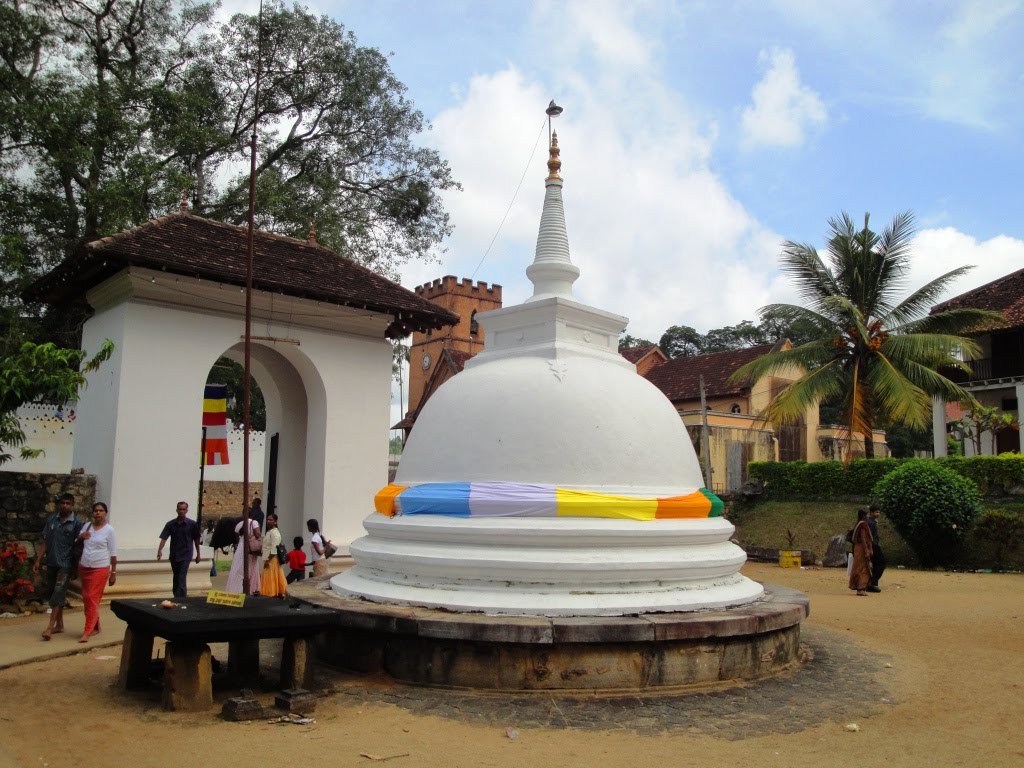
Natha Dewale is the oldest shrine in Kandy, built in the 14th century. One of the best examples showing the influence of South Indian architecture; a stone built structured depicting three storeys, surmounted with a domical stupa on top of the inner chamber is entered through an open colonnade hall. The two upper storeys are non functional. It has a beautiful bronze icon if God Lokeshwera Natha, a Bodhisathwa of the Mahayana ornamented double roofed archway, a good or typical example of an entrance gateway in Sinhalese architecture.
Situated to the west of Natha Devale across the Eth Veediya (Elephant street) is the Pattini Devale. A simple, small mud built rectangular building with an imposing roof on the top. This shrine is dedicated to the Goddess of Chastity, Pattini Deviyo.
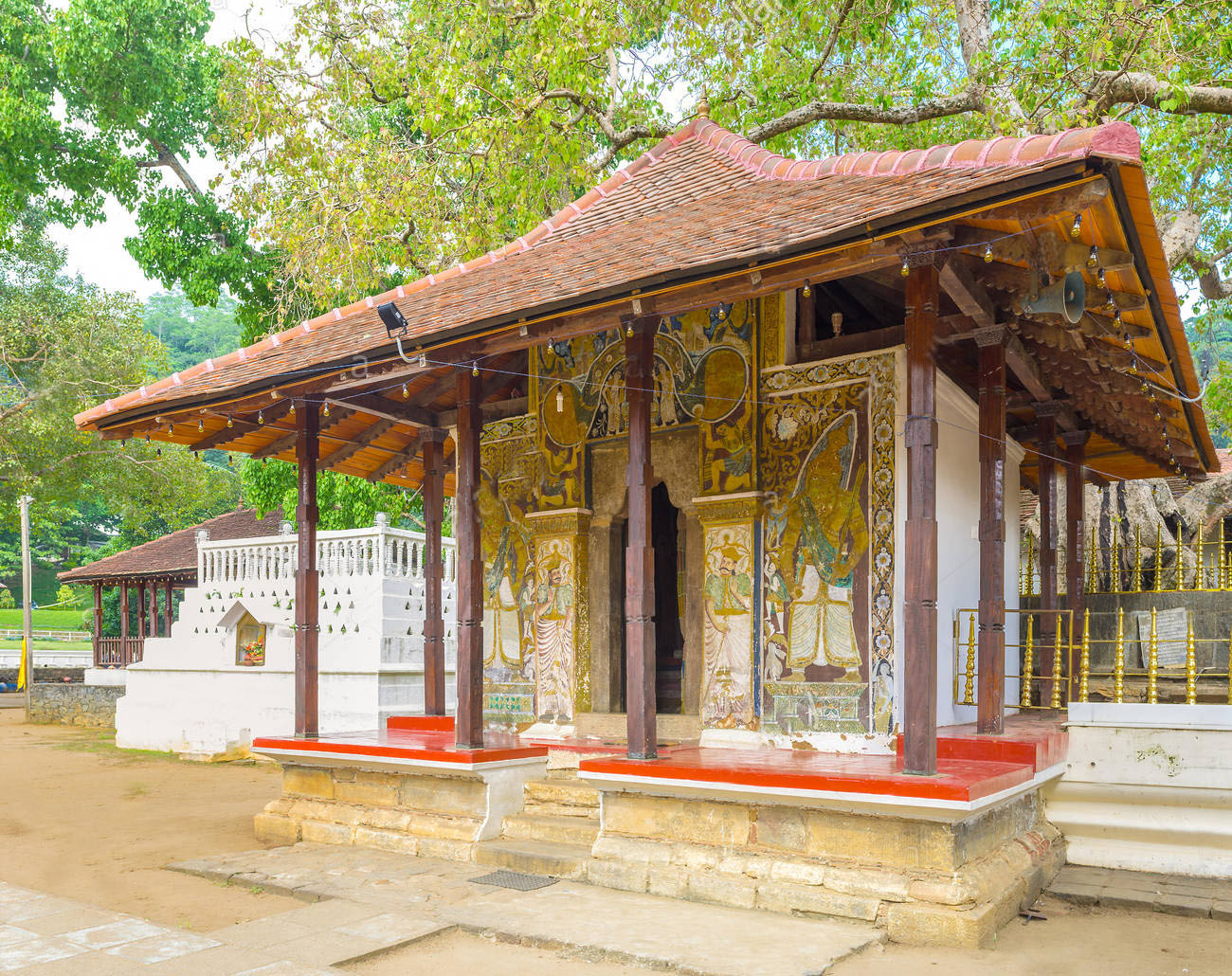
.jpg)
Outside the entrance archway to pattini Devale at the Northern wall is an ancient Bo - tree shrine, 'Wel Bodiya on top stepped terraced platform. This Bodhi tree, is venerated as one of the off-shoots of the Sacred Bo - tree on Anuradhapura.
Premises if this shrine is little away from the Palace, has its access from the commercial area through a colourful ornament gateway. A linear building with a two stroyed section above the sanctum. The icon of the God Katharagama or Skanda represented by a figure with six heads, twelve hands and riding on a Peacock chariot.
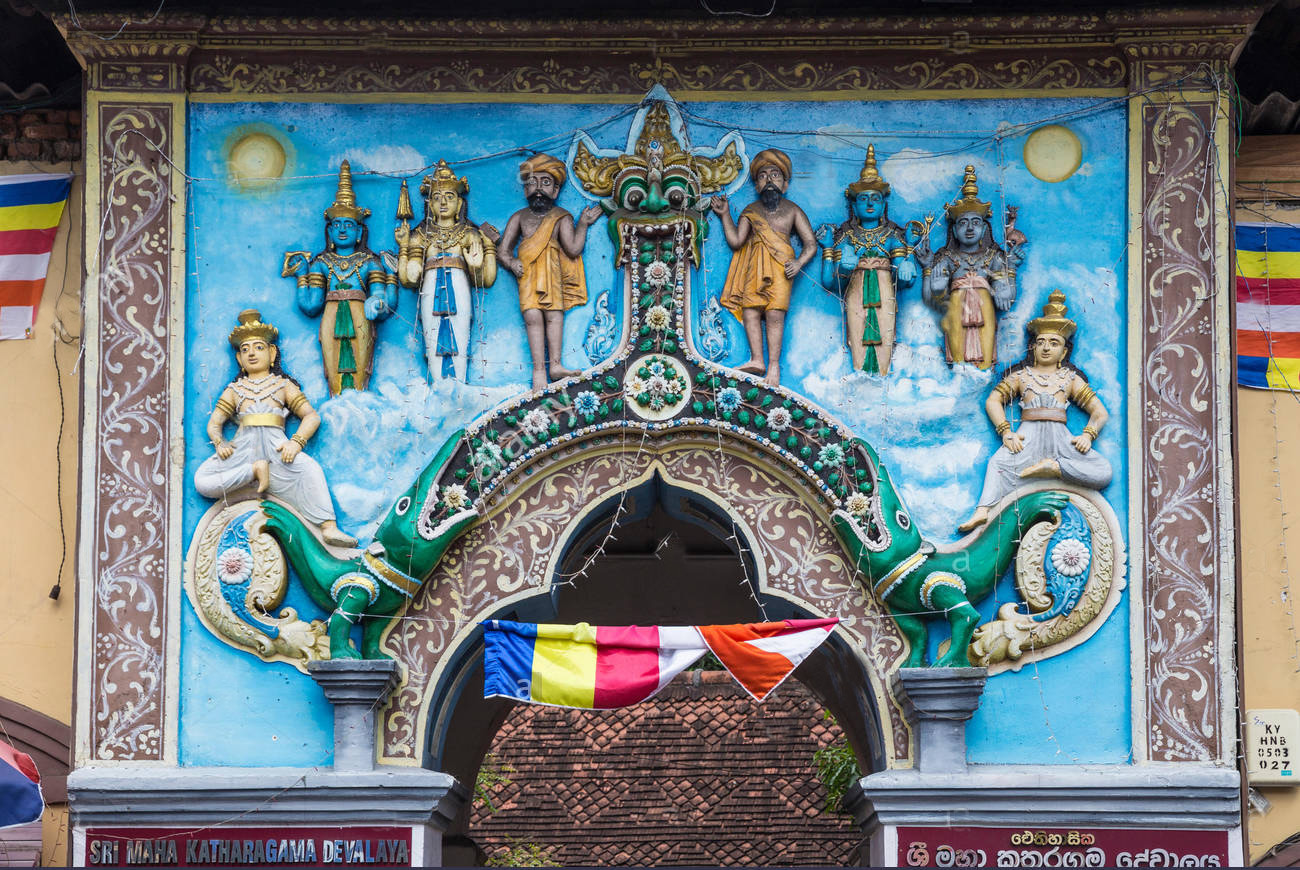
Situated about 2 Kilo meters to the Palace complex, the image house is built around a ten meter high standing Buddha statue, carved out of an in-situ natural rock. The central hall at the building covered with a double pitched hipped roof is cladodes with flat clay tile. The lower roof covers the verandah built around the central hall. Entrance to the central shrine is through a decorated arched door. The walls of the shrine are completely covered with finely drawn murals that speak of the artistic and religious concepts of the ancient kings.
The best garden in the country that one should never miss visiting. Begun as a Pleasure Garden of a Kandyan King, the Royal Botanical Gardens at peradeniya is surrounded by the river Mahaweli on three sides and is connected to the opposite bank by a suspension bridge. The garden itseif is an example of the wealth and beauty of the tropics with over hundred varieties of palm trees, palm avenues, where the palms such as Talipot grow to an ammense size, wondrous arches of glossy foliage, lovely fernery and orchid houses with rare blossoms and spice tress in groves make it a rich botanical heritage.
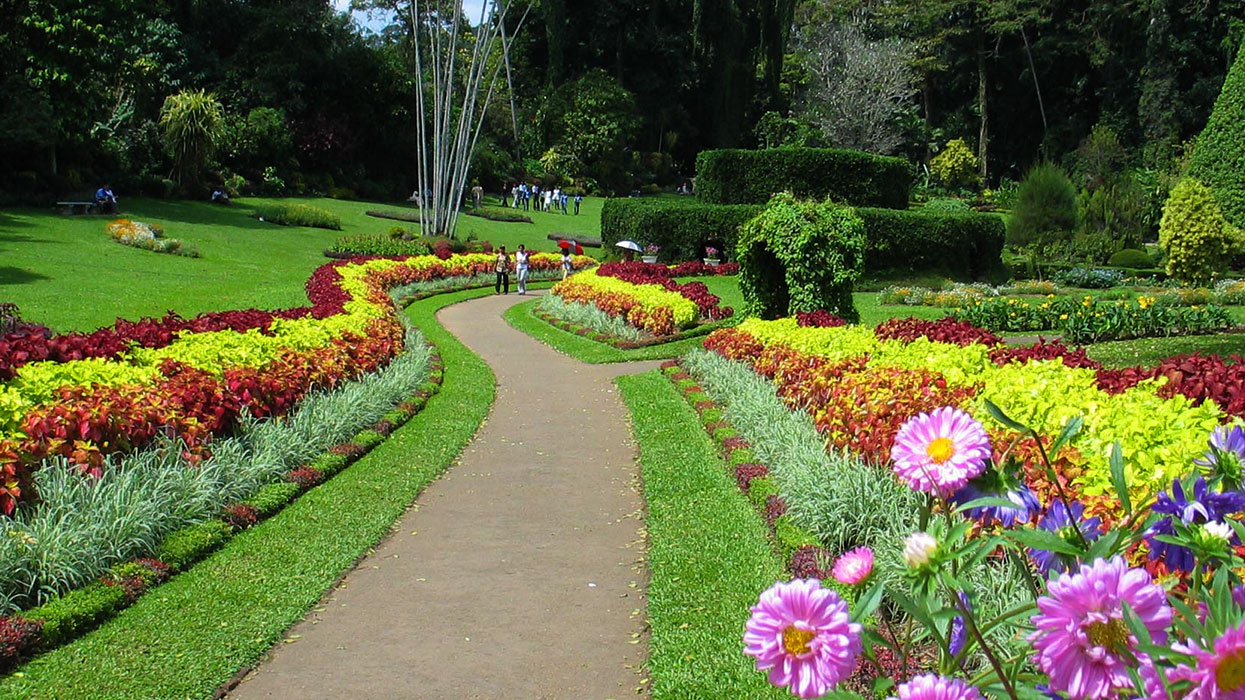

The Lake at the center of the city with a traditional artistic feature is attractive and keeps the environment cool. So, the city is considered as one of the best tourist resorts of the island. This was built by the last king Conceptually, it is a monumental creation of 'Kiri Muhuda' (Milk Sea). The banks of the lake has become the popular walking stretch of the city dwellers and lovers.